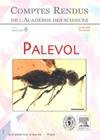Taxonomy and palaeoecology of the fossil anamorphic fungus Mycoenterolobium eccentricum (R.K. Kar) G. Worobiec, n. comb.
IF 1.3
4区 地球科学
Q3 PALEONTOLOGY
引用次数: 0
Abstract
Microremains of fungi from Neogene deposits from the Gray Fossil Site (Tennessee, United States) and the Bełchatów Lignite Mine (Poland), similar to the enigmatic fossil-species Kutchiathyrites eccentricus R.K. Kar, 1979, were reconsidered as representatives of the modern mitosporic genus Mycoenterolobium Goos, 1970. A new combination, Mycoenterolobium eccentricum (R.K. Kar) G. Worobiec, n. comb., is proposed. The geographical and stratigraphical range and ecology of the fossil and modern Mycoenterolobium species are discussed. Investigated remains of Mycoenterolobium eccentricum (R.K. Kar) G. Worobiec, n. comb. document the first fossil record of this fungus from both Northern America and Europe, while the Bełchatów mine represents the northernmost known fossil and modern occurrence of the Mycoenterolobium genus. Both modern and fossil species of Mycoenterolobium seem to prefer warm (tropical to warm temperate), usually humid climates. They are associated with plant debris (mainly wood) decaying in a damp or aquatic environment. Mycoenterolobium eccentricum (R.K. Kar) G. Worobiec, n. comb. is suggested to be used as a non-pollen palynomorph proxy for palaeoclimatic and palaeoenvironmental reconstructions.变形真菌Mycoenterolobium eccentricum (R.K. Kar) G. Worobiec, n. comb.。
美国田纳西州灰色化石遗址(Gray Fossil Site)和波兰Bełchatów褐煤矿(Lignite Mine)新近纪沉积物中的真菌微遗存,与神秘的化石物种Kutchiathyrites eccentricus R.K. Kar, 1979相似,被重新认为是现代有丝孢子真菌属(Mycoenterolobium Goos, 1970)的代表。一个新组合,Mycoenterolobium eccentricum (R.K. Kar) G. Worobiec, n. comb.。,建议。讨论了古真菌肠菌属和现代真菌肠菌属的地理、地层范围和生态学。离心分枝肠杆菌(R.K. Kar) G. Worobiec, n. comb.。在北美和欧洲都发现了这种真菌的第一个化石记录,而Bełchatów矿则代表了最北的已知化石和真菌属的现代出现。现代和化石种的分枝杆菌似乎更喜欢温暖(热带到暖温带),通常是潮湿的气候。它们与植物残骸(主要是木材)在潮湿或水生环境中腐烂有关。偏心肠杆菌(R.K. Kar) G. Worobiec, n. comb。建议作为古气候和古环境重建的非花粉孢粉形态代用物。
本文章由计算机程序翻译,如有差异,请以英文原文为准。
求助全文
约1分钟内获得全文
求助全文
来源期刊

Comptes Rendus Palevol
地学-古生物学
CiteScore
2.10
自引率
0.00%
发文量
39
审稿时长
17.6 weeks
期刊介绍:
Comptes Rendus Palevol is a fully electronic and peer-reviewed journal, with a continuous publication stream, devoted to palaeontology, prehistory and evolutionary sciences. It publishes original research results, in French or English, in the following domains: systematic and human palaeontology, prehistory, evolutionary biology and macroevolution, and history of sciences. Thematic issues may also be published under the responsibility of a guest editor. All articles published in Comptes Rendus Palevol are compliant with the different nomenclatural codes. A copyright assignment will be signed by the authors before publication.
 求助内容:
求助内容: 应助结果提醒方式:
应助结果提醒方式:


